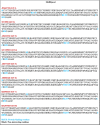Role of "dual-personality" fragments in HEV adaptation-analysis of Y-domain region
- PMID: 34637041
- PMCID: PMC8511232
- DOI: 10.1186/s43141-021-00238-8
Role of "dual-personality" fragments in HEV adaptation-analysis of Y-domain region
Abstract
Background: Hepatitis E is a liver disease caused by the pathogen hepatitis E virus (HEV). The largest polyprotein open reading frame 1 (ORF1) contains a nonstructural Y-domain region (YDR) whose activity in HEV adaptation remains uncharted. The specific role of disordered regions in several nonstructural proteins has been demonstrated to participate in the multiplication and multiple regulatory functions of the viruses. Thus, intrinsic disorder of YDR including its structural and functional annotation was comprehensively studied by exploiting computational methodologies to delineate its role in viral adaptation.
Results: Based on our findings, it was evident that YDR contains significantly higher levels of ordered regions with less prevalence of disordered residues. Sequence-based analysis of YDR revealed it as a "dual personality" (DP) protein due to the presence of both structured and unstructured (intrinsically disordered) regions. The evolution of YDR was shaped by pressures that lead towards predominance of both disordered and regularly folded amino acids (Ala, Arg, Gly, Ile, Leu, Phe, Pro, Ser, Tyr, Val). Additionally, the predominance of characteristic DP residues (Thr, Arg, Gly, and Pro) further showed the order as well as disorder characteristic possessed by YDR. The intrinsic disorder propensity analysis of YDR revealed it as a moderately disordered protein. All the YDR sequences consisted of molecular recognition features (MoRFs), i.e., intrinsic disorder-based protein-protein interaction (PPI) sites, in addition to several nucleotide-binding sites. Thus, the presence of molecular recognition (PPI, RNA binding, and DNA binding) signifies the YDR's interaction with specific partners, host membranes leading to further viral infection. The presence of various disordered-based phosphorylation sites further signifies the role of YDR in various biological processes. Furthermore, functional annotation of YDR revealed it as a multifunctional-associated protein, due to its susceptibility in binding to a wide range of ligands and involvement in various catalytic activities.
Conclusions: As DP are targets for regulation, thus, YDR contributes to cellular signaling processes through PPIs. As YDR is incompletely understood, therefore, our data on disorder-based function could help in better understanding its associated functions. Collectively, our novel data from this comprehensive investigation is the first attempt to delineate YDR role in the regulation and pathogenesis of HEV.
Keywords: Molecular function; Nucleotide-binding propensity; Phosphorylation; Protein disorder; Protein structure; Protein-binding propensity; Y-domain region (YDR).
© 2021. The Author(s).
Conflict of interest statement
The authors declare that they have no competing interests.
Figures









Similar articles
-
Intrinsic disorder in the open reading frame 2 of hepatitis E virus: a protein with multiple functions beyond viral capsid.J Genet Eng Biotechnol. 2023 Mar 16;21(1):33. doi: 10.1186/s43141-023-00477-x. J Genet Eng Biotechnol. 2023. PMID: 36929465 Free PMC article.
-
Amino acid pattern reveals multi-functionality of ORF3 protein from HEV.Bioinformation. 2024 Feb 29;20(2):121-135. doi: 10.6026/973206300200121. eCollection 2024. Bioinformation. 2024. PMID: 38497081 Free PMC article.
-
Decoding the codon usage patterns in Y-domain region of hepatitis E viruses.J Genet Eng Biotechnol. 2022 Apr 11;20(1):56. doi: 10.1186/s43141-022-00319-2. J Genet Eng Biotechnol. 2022. PMID: 35404024 Free PMC article.
-
The dark proteome of cancer: Intrinsic disorderedness and functionality of HIF-1α along with its interacting proteins.Prog Mol Biol Transl Sci. 2019;166:371-403. doi: 10.1016/bs.pmbts.2019.05.006. Epub 2019 Jun 8. Prog Mol Biol Transl Sci. 2019. PMID: 31521236 Review.
-
Hepatitis e: molecular virology and pathogenesis.J Clin Exp Hepatol. 2013 Jun;3(2):114-24. doi: 10.1016/j.jceh.2013.05.001. Epub 2013 May 30. J Clin Exp Hepatol. 2013. PMID: 25755485 Free PMC article. Review.
Cited by
-
Intrinsic disorder in the open reading frame 2 of hepatitis E virus: a protein with multiple functions beyond viral capsid.J Genet Eng Biotechnol. 2023 Mar 16;21(1):33. doi: 10.1186/s43141-023-00477-x. J Genet Eng Biotechnol. 2023. PMID: 36929465 Free PMC article.
-
Intrinsically disordered regions in the rodent hepevirus proteome.Bioinformation. 2022 Feb 28;18(2):111-118. doi: 10.6026/97320630018111. eCollection 2022. Bioinformation. 2022. PMID: 36420436 Free PMC article.
-
Amino acid pattern reveals multi-functionality of ORF3 protein from HEV.Bioinformation. 2024 Feb 29;20(2):121-135. doi: 10.6026/973206300200121. eCollection 2024. Bioinformation. 2024. PMID: 38497081 Free PMC article.
-
Role of microRNAs in chronic hepatitis E viral infection.Bioinformation. 2025 Feb 28;21(2):240-252. doi: 10.6026/973206300210240. eCollection 2025. Bioinformation. 2025. PMID: 40322700 Free PMC article.
-
Hepatitis E genotype 3 genome: A comprehensive analysis of entropy, motif conservation, relevant mutations, and clade-associated polymorphisms.Front Microbiol. 2022 Oct 6;13:1011662. doi: 10.3389/fmicb.2022.1011662. eCollection 2022. Front Microbiol. 2022. PMID: 36274715 Free PMC article.
References
LinkOut - more resources
Full Text Sources
Research Materials
